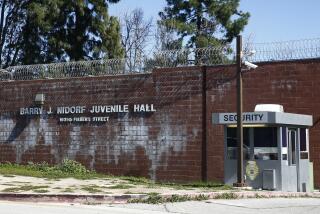Population of prisons to increase
SACRAMENTO — After declining for six years, California’s prison population is expected to grow by 10,000 inmates in the next five years, complicating Gov. Jerry Brown’s effort to abide by a court order to reduce overcrowding.
New state population projections show criminals heading to prison at the same rates expected before Brown began to shrink the prison population by keeping low-level, nonviolent felons in county jails after their convictions rather than sending them to state lockups.
The reason for the growing prison population is under debate.
County prosecutors dispute suggestions that they are more frequently pursuing charges that put felons in prison instead of jail. Others cite violent crimes committed by felons or parolees cycling in and out of overcrowded jails since the new prison policy, called realignment, took effect in October 2011.
State statistics do not show a rise in violent crime.
Even with room for 3,700 more beds planned over the next two years and the rollout of new parole programs Brown announced Thursday, California would be increasingly far from the inmate population limit set by the court.
The new projections were released by the state Department of Corrections and Rehabilitation in late December, months later than normal.
The report comes as California faces the threat of contempt if it fails to meet an order by three federal judges to ease crowding in the state’s 34 prisons.
The judges have ruled that prison overcrowding has created unconstitutionally dangerous conditions in those facilities.
“This is a scary problem, and I can see why they hid it,” said Michael Bien, the lead attorney in one of two long-running class action lawsuits over prison deaths that led to the population caps.
Corrections officials said the report was not deliberately delayed but was subject to several months of internal review, prolonged by the need to explain the shift in direction.
“Our department gathers data like this so that we can project our future population and make appropriate staffing, facility and funding decisions,” said department spokesman Jeffrey Callison.
The Brown administration had calculated that, by now, realignment would have lowered inmate numbers by 32,000. State prison statistics show a reduction of 22,000.
The new report from the corrections department shows a sharp increase that, even with $500 million in expansion projects recently announced for two prisons, would give California 26,000 more inmates than the judges will allow.
To meet their limits, the state would have to more than double its current spending on beds in privately owned prisons and other alternatives.
Those projections do not factor in Brown’s announcement that he could immediately begin releasing about 440 additional prisoners. Annual estimates were not provided.
The corrections department attributes much of the projected increase in inmates to a dramatic jump in convicted felons -- a 36% rise in admissions in 2013 alone -- sentenced under the state’s “three strikes” law.
Although voters in 2012 eased penalties for third strikes, state officials said nonviolent felons were still going to prison instead of jail because prosecutors had charged them with second strikes.
State reports show the number of felons arriving in prison with two strikes began rising immediately after the Legislature passed Brown’s realignment program in late 2011. That part of the prison population is now more than 34,000 inmates, a record high.
Brown’s administration raised questions about the practice with prosecutors last fall, said Mark Zahner, chief executive of the California District Attorneys Assn.
Zahner rebuts the suggestion that prosecutors are purposefully sending more criminals to the state.
“We have not changed our policies to create more opportunities to go to prison rather than jail,” Zahner said.
A copy of a document that administration officials showed the prosecutors’ group displays a handful of counties responsible for most of the increase.
They are led by Riverside and Fresno, which increased second-strike convictions by 34% and 86%, respectively.
Others contend the cause isn’t prosecutors but crime.
“By churning these criminals in the county system, we keep them out [of prison] until eventually they hurt somebody,” said Michael Rushford, president of the Criminal Justice Legal Foundation.
--
More to Read
Sign up for Essential California
The most important California stories and recommendations in your inbox every morning.
You may occasionally receive promotional content from the Los Angeles Times.











